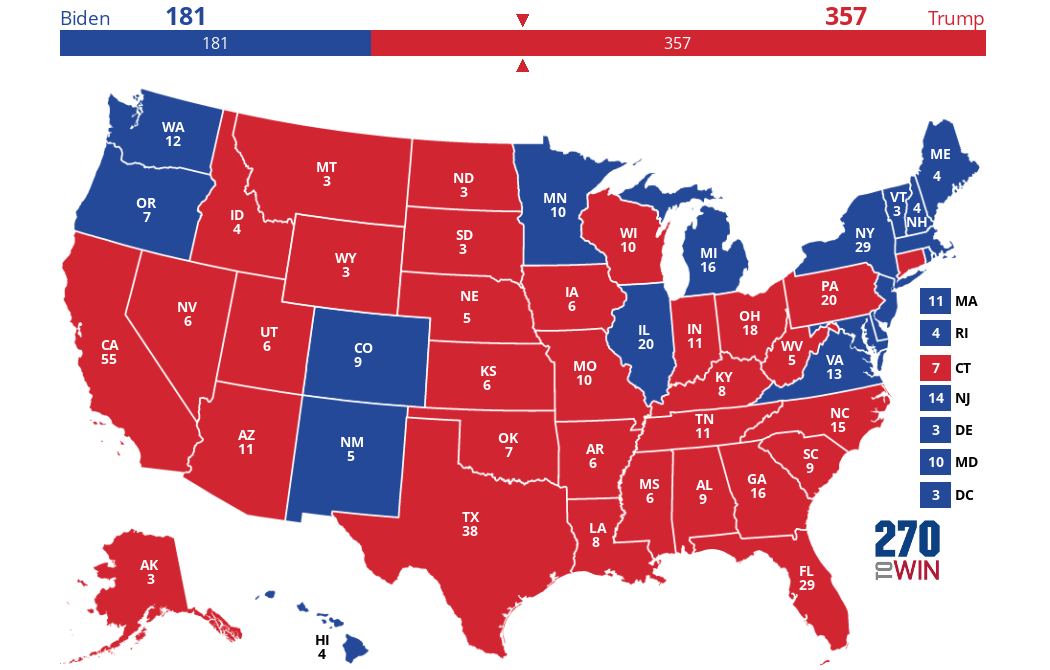 |
US 2020 Presidential Election PredictionsThis is the only site with all 2020 US Election Predictions
|
Citizen Forecasting 2020: A State-by-State Experiment by Andreas Murr, University of Warwick, England and Michael Lewis, University of Iowa.
The standard polling question, "If the election were held tomorrow, who would you vote for?" is well known. Usually, some preliminary questions are asked to determine if the person is likely to vote. Or if they are registered to vote. If the question were significantly different, would the results change? This study asks the question, "Which candidate for president do you think will win in this state?" And in 2020, timing is everything. This survey was conducted in July 2020.
Those participating in the survey were given a much more difficult question, as they were asked what the majority of the voters in the state would select. The authors defend soliciting the citizens of the state in forecasting the election outcome in their state. Also, they document well the methodology of their model.
When I look at their map of Model-based Election Forecast by State (figure 4), it looks in general quite reasonable for most states. I've taken the liberty of duplicating it below, with Trump winning 357 electoral votes or 66% of the electoral college.
California is predicted to go Republican by the model, so Trump picks up 55 electoral votes or 10.2% of the total vote (538 votes). California is predicted by the survey of only 60 respondents to the survey, in which the forecast Biden voting share was 45.7%.
There are 3 reasons why California will likely go to Biden:
1. California has voted Democrat since 1980,
2. Surveys have shown Democrats leading in the polls by about 30% since April 2020.
3. Hillary Clinton won California 61% to 31.6%. In the last 40 years, a comparison of the absolute value of changes in voter share, in successive elections has exceeded 10% only three times, with the record being Hawaii (Obama's birth place) in 2008. So, it would be an incredible upset if Biden lost California. Links provided below. So, if California goes Democrat, the forecast now becomes Trump 304 to Biden 224 EV's.
The same three arguments can be made for Biden winning Connecticut, consistently voted Democrat, ahead by 22% in polls, and Clinton won state in 2016 by a wide margin (14%). So, that would put Trump at 297 EV's to Biden 241 EV's, and Trump's cushion has vanished.
Yet, to be fair, Trump could pick up Michigan which Trump won in 2016 by a very close margin, adding 16 EV's to a Trump victory of 313 EV's to Biden's 225 EV.
Also, in discussing the results, the authors point out that responses if taken for the entire nation, show 51.35% favored Biden. However, this was not enough, as the national forecast model gives a slight edge to the incumbent, and Biden's expection score (39.3 + 0.2 * (51.35) = 49.6%) still indicates a Trump victory, but only by 0.4%. Biden needs 51.5% of the responses to come out on top.
I will know shortly if my criticisms have any merit. Certainly, this paper should raise questions for future students of election predictions, admittedly my case. Was it proper to ask ordinary citizens to forecast their entire state, or should this be left to experts in the area? Was there correlation between the responses and their registered party? Was the sample size too small for a large and diverse state as California? I'm also wondering how many respondents simply avoided the question. If I was asked in July, how my state Florida would vote, I would say, that it was impossible to know. I would not have any problem answering the more personal question of who I would vote for.
David Lord
Links:
Skyler Dale, Medium.com (Provides cases where there is a change in voting share > 10%)
Wikipedia: US Elections

 Click the map to create your own at
Click the map to create your own at